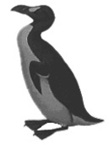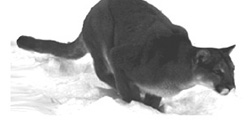The Extinction Club (41 page)
Read The Extinction Club Online
Authors: Jeffrey Moore

They have an extraordinary love for one another, which extends so far that when one of them was cut into, all the others were intent on rescuing it & keeping it from being pulled ashore by closing a circle around it. Others tried to overturn the yawl. Some placed themselves on the rope or tried to remove the hook from the wound in the back by blows of their tail, in which they actually succeeded several times….
It is most remarkable proof of their conjugal affection that a male, after having tried with all his might, although in vain, to free a female caught by the hook, and in spite of the beating we gave him, nevertheless followed her to the shore, and that several times, even after she was dead, he shot unexpectedly up to her like a speeding arrow. Early next morning, when we came to cut up the meat & bring it to the dugout, we found the male again standing by the female, and the same I observed on the third day….
After modern man first saw it, the Sea Cow survived for only 27 more years. Which makes it the all-time record-holder for the quickest extermination of any species.


Great Auk
The 10th-century Vikings were probably the first Europeans to see these fabulous flightless birds, these “penguins of the North.” They were quick in water but slow on land. So they were totally helpless when nesting.
When Jacques Cartier visited Funk Island off the coast of Newfoundland in 1535, his crew captured hundreds of the birds & crammed them into barrels. And robbed the nests of as many eggs as his crew could carry. The Great Auks nested not only around Newfoundland, but also on the Magdalen Islands in the Gulf of St. Lawrence, and in the Gulf of Maine & Massachusetts Bay. In the eastern Atlantic, they nested on various islands, especially St. Kilda (off the west coast of Scotland), and
several tiny islands off Iceland. Everywhere they nested, they were slaughtered.
Here’s how the Auks were greeted on Funk Island off Newfoundland circa 1800. Thousands of the birds were herded into huge pens, crammed so tight the poor things could barely move. Gangs of men then waded through the birds swinging spiked clubs, either killing them or stunning them. Other men followed the strikers & threw the birds over the walls of the pen into piles by the fire pits. To loosen their plumage, they were boiled dead or alive in giant cauldrons with the oil of the birds killed before them. Another gang stripped the feathers off them, which would be sold to make pillows & powder puffs. The naked bodies were then thrown into the fire.
By 1830 there were almost no Great Auks left in the world. Their last stronghold was Geirfulasker, a volcanic island off the coast of Iceland, which erupted that year & sank. The few birds that were left had just one place to go — the island of Eldey. On June 3, 1844, some sailors landed there, sent by a collector to see if any Great Auks could be found. They spotted a pair standing high above the smaller seabirds. The female was sitting on an egg — a last hope for the future of the birds. The two Great Auks frantically tried to reach the water, but one was trapped between some rocks, and the other was caught at the very edge of the sea. Both were clubbed to death. And the egg was crushed under a sailor’s boot.


Eskimo Curlew
This AMAZING bird had the most complicated & dangerous migration cycle ever. It started in the north, in the Canadian sub-arctic, then followed a huge clockwise circle: east through Labrador, down through the Atlantic & across the southern Caribbean, then on & on until reaching the Argentinean Campos south of Buenos Aires! In the spring it completed the cycle, crossing Texas & making its way through Kansas, Missouri, Iowa & Nebraska back to Canada. It seems to have travelled with every single one of its species, in one gigantic flock. Some people compared their singing to the “jingle of sleigh bells.”
When they landed the sight must have been awesome: a flock covering nearly 50 acres was once seen in Nebraska. But you have to realize that this might’ve been the entire world population of Curlews.
When the birds reached Newfoundland they were stalked along the beaches. Men would come after them in the darkness, blinding them with lanterns & hitting them with sticks. When the Curlews got blown into New England by gales, every gunner got to work.
On their northern route over the great plains, the “prairie pigeons” flew into gigantic ambushes, annual massacres. Hunters would fill wagonload after wagonload of dead birds. Sometimes they’d leave huge piles of them to rot & then go back & shoot some more.
In the late ’50s there were some sightings (and even one photograph) of single migrating birds in Texas, and in 1964 a Curlew was shot in Barbados. People still report seeing them from time to time. But assuming they’re not seeing ghosts, there’s no hope for these single survivors. Their instinct is to migrate the length of two continents — but in the safety of large numbers. So if there are any Eskimo Curlews still out there, they’re doomed.


Eastern Cougar
This big cat goes by many names — Cougar, Catamount, Mountain Lion, Panther, Puma concolor — and once roamed over all of the Laurentians, all over this continent, by the tens of thousands, in the old-growth Boreal forests. They were wiped out — hunted, poisoned, trapped — a half-century ago. Up near Mont Tremblant, a guy named Jimmy Doucette turned in over 200 cougar scalps for the bounty between 1896 and 1906. Today, the only mountain lion remaining in the Laurentians is Kitty, a stuffed & moth-eaten specimen on display at The Cave on Hwy 117, killed on Christmas Day in 1958. Officially, the animal is extinct.
But people up here keep claiming they see cougars or their tracks up & down the Laurentians. And scientists say there may be a small number of them living in the wild. In the 1990s DNA evidence from droppings confirmed that they hung out in Quebec, Vermont & Massachusetts. And an apparently healthy male cougar was killed by a bus near St-Jovite in the summer of 2006.
Nile says he’s seen a big cat in the cemetery, once in December, once in January. And I believe him even if he doesn’t believe it himself. It’s the only hope I’ve got left, it’s all I cling to — that the woods out there are still big & deep enough for the last of their lines to live.
 XXIX
XXIX 
The squad car, its gumball turning, did not pull me over. Its driver was speeding too, obviously out for bigger fish than a two-beer joyrider like me. I eased my foot onto the brake, pulled back into my lane. Spared for a future time.
